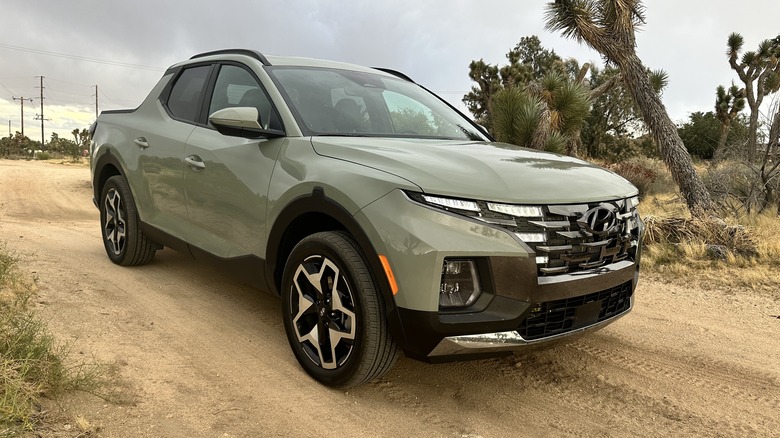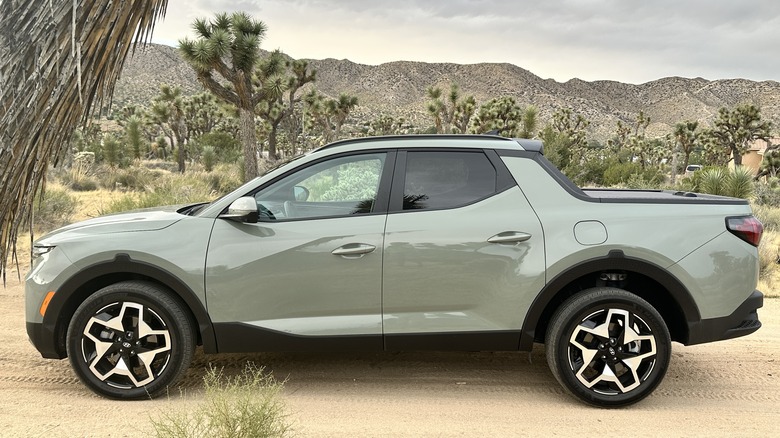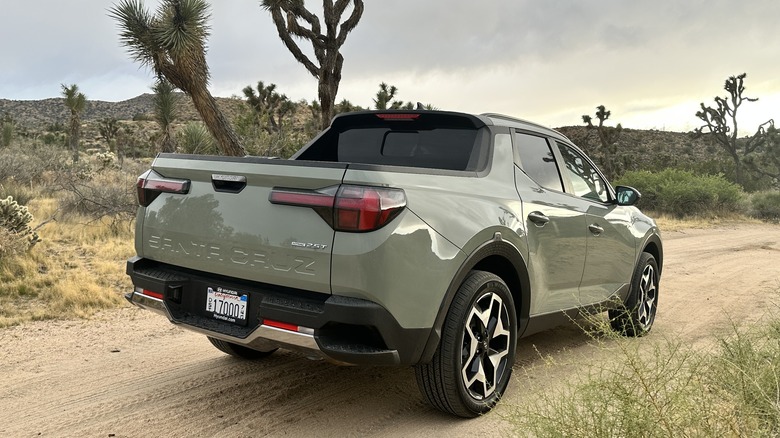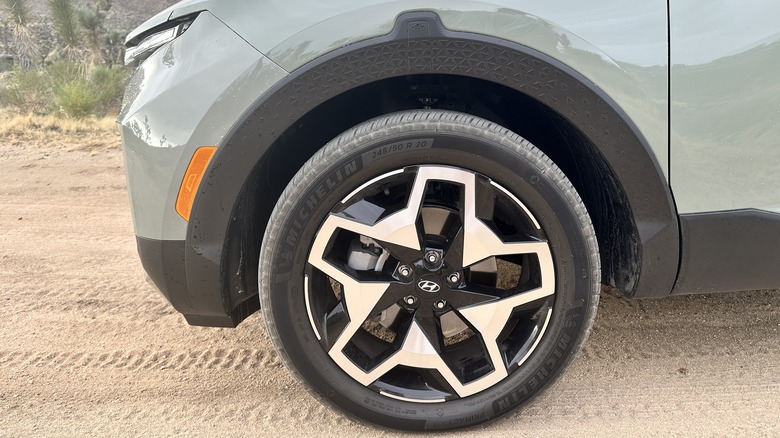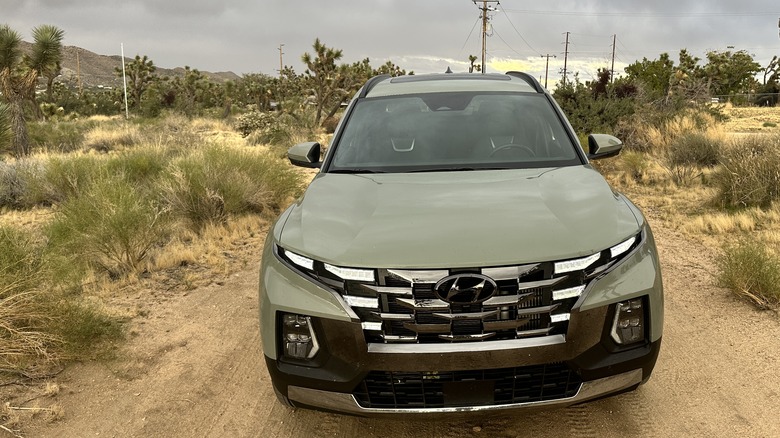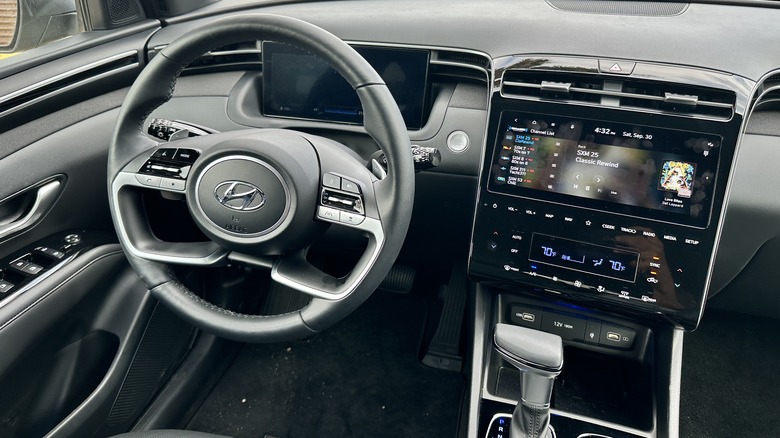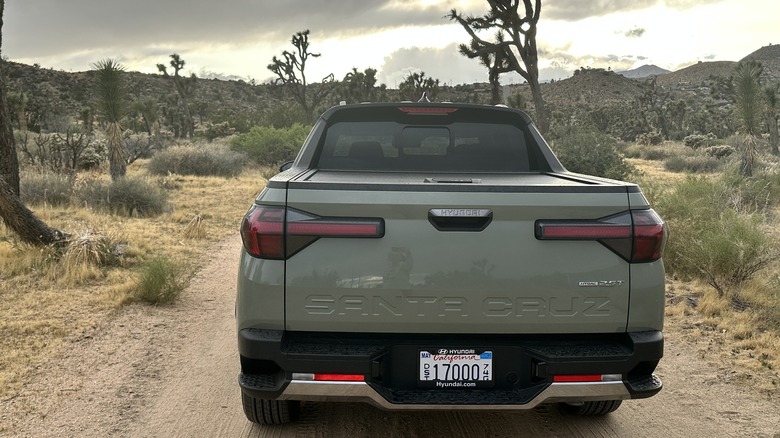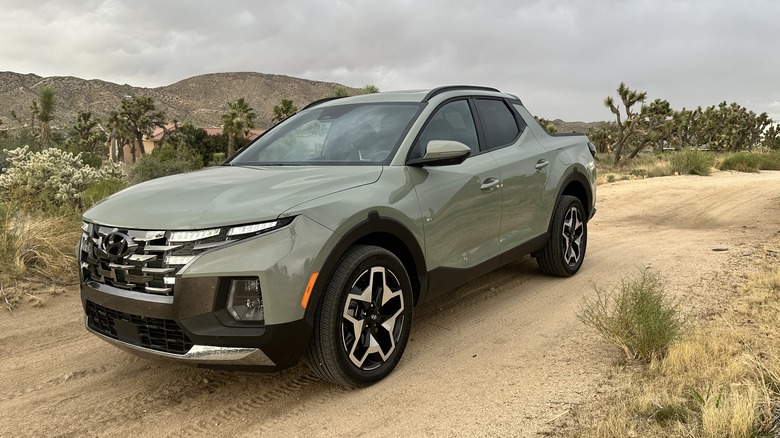2024 Hyundai Santa Cruz Review: The Utility You Need In A Small Package
- Excellent utility for size
- Peppy turbocharged engine
- Extra-strong heated seats
- Wireless Apple CarPlay and Android Auto only on smaller screen
- Can get pricey
- Fuel economy could be better
While driving in stop and go traffic the other day I saw something I never thought would grace my eyeballs. It was a lifted 2024 Hyundai Santa Cruz. Y'all, someone finally did what I have always said should be done. Unfortunately it scooted away before I had a chance to snap a photo, but it brings me to the subject of this review. Sure, the one provided by Hyundai wasn't lifted but it came to me in the top Limited trim and proved its utility mettle on a quick camping trip.
The little truck–we'll call it a truck even though technically it's a unibody crossover with a bed–is available in SE, SEL, Night, XRT, and Limited trims. By and large it's the same vehicle we've loved since 2021, but the 2024 model year gets a few upgrades.
The SEL trim is nixed, replaced by the XRT. Lighting gets an upgrade to bi-LED projector headlamps across the board, and haptic steering wheel feedback is added to give a buzz if the driver upsets the lane keeping assist or blind-spot monitoring systems. SEL and up trims now get dual-zone automatic climate control and the larger 10.25-inch infotainment screen with navigation is optional on the SEL trim, standard above that.
Future-proof looks
We're still digging the Santa Cruz' futuristic front end, shared with its sister crossover the Hyundai Tucson. This thing stands out in a crowded parking lot, even though its external color palette is pretty muted. My favorite is Blue Stone, but I would love something a bit brighter overall.
The inside isn't quite as character-driven, save for the funky horizontally-spoked steering wheel, but the materials are nice for this price point. The optional 10.25-inch digital dash is a separate screen kind of plunked down behind the steering wheel, which may seem a bit odd to some folks. However, I like how clear the graphics are and it's way better than the tiny 4.2-inch display on lower trims.
Heated front seats are standard on all but the base model and they are glorious. You get three levels of hiney-scalding temperatures and they Do. Not. Quit. Once the highest level is selected they keep the fire on until your butt bursts into flames. As someone who is annoyed when other cars decrease the heat after a certain time, I love it. More sane folks might want to keep them to level 2.
Ventilated seats are here as well but they don't offer the inverse level of fanny-freezing and they are only available on the top Limited trim.
Tow and haul more than you think you can
I use the Santa Cruz primarily for a quick camping trip and I quickly get to loading up the 52-inch long bed with gear. The Santa Cruz has a payload rating of 1,411 pounds for this nearly square bed, but be aware there is only 43 inches between the wheel wheels. Still, it's enough to haul two chairs, an air compressor, cot, tent, sleeping bag, Easy Up shade tent, two Maxtrax recovery boards and various pieces of recovery gear. I slide the tonneau cover shut to keep it out of the view of thieving eyes and I'm good to go.
One little quibble here about that tonneau cover. It's lockable, which is great, but the latch to open it seems a bit fussy. I almost feel like I'm going to break it when trying to open the damn thing. Something a bit more robust would be welcome.
I don't tie anything down but there are multiple tie down points as well as sliding rail anchors. There is even lockable underfloor storage and a few cubbies in the side of the bed for smaller items. Finally, the bumper has a corner step for easy bed access. Frankly, this is all the utility most folks need.
If you need to tow with your Santa Cruz your best bet is to go with the all-wheel drive set up and get yourself a braked trailer. A front-wheel drive version can haul 3,500 pounds, the all-wheel drive goes up to 5,000 pounds. However, if your trailer does not have integrated brakes, the Santa Cruz can only tow 1,650 pounds. Sorry folks, but the 12.8-inch brake rotors on the little trucklette just can't handle all that weight.
Go for the turbo
Packed up with gear and snacks, I'm ready to hit the road. Lower trims get a naturally aspirated 2.5-liter four-cylinder engine with 191 horsepower and 181 pound-feet of torque. My Limited trim adds a turbocharger, pushing the output to 281 ponies and 311 pound-feet of torque. What's more, the smaller mill's 8-speed automatic transmission is replaced with a dual-clutch set up for quicker gear changes.
Drive modes here are Normal, Sport, Smart, and Snow, all varying the shift points, throttle response, all-wheel drive system, and traction control. The Santa Cruz is most enjoyed in Sport mode–at least on my dry desert roads–where the peppy engine holds its revs longer allowing for easy passing and a 0-60 mile per hour time of about six seconds. That's not lightning fast but taken in perspective it's pretty good. After all, a Mazda MX-5 Miata isn't much quicker.
Hyundai says a Santa Cruz equipped with the naturally aspirated engine has an efficiency of 23 miles per gallon combined. Our turbo tester should net 22 mpg combined. During my nearly 600 miles with the Santa Cruz, I average 23.3 mpg combined. Go me!
Unexpectedly capable off-road
However, if fuel efficiency is your jam, you should look at the Ford Maverick. The hybrid powertrain can manage 37 mpg combined, the front-wheel drive 25 mpg combined and the all-wheel drive 24 mpg combined. The only trim that does worse is the off-road spec Tremor at 21 mpg combined.
Speaking of off-road, you may want to take your Santa Cruz into the dirt and I highly encourage that notion. Hyundai has fielded a Santa Cruz in the 7-day off-road navigational challenge Rebelle Rally for the past two years, finishing each time with no major issues. I recommend swapping out the all-season Michelin Primacy all-season tires for something a bit more robust and adding some skid plating to the underbody.
Ground clearance here is just 8.6 inches. Sure, that's commensurate with other crossovers, and it's close to what some midsize truck trims offer, but it still ain't much. The approach angle sits at 17.5 degrees, departure angle at 23.2 degrees, and breakover angle at 18.6 degrees. Do you now understand why I was so excited to see someone actually lift one of these suckers?
Still, the reason to buy a Santa Cruz is not its off-road capability. You should buy one because of the amount of utility it has crammed into a relatively small package. It can tow and haul almost as much as a much larger traditional mid-size truck, but it's much more maneuverable. Crowded garages are a breeze, it's easy to drive in traffic and parallel parking on the street is a snap.
Small screen but no wires
Lower trims come with an 8-inch touchscreen for Hyundai's infotainment system, but my Limited tester is equipped with the larger 10.25-inch screen. I love how quickly the system responds to touch and the graphics are crisp and clear. On the whole the system is well-organized without a bunch of menus and sub-menus and it's easy to set a radio favorite. If you don't want to go digging through the screen there is a set of touch-sensitive physical button panels–they aren't buttons you can actually click to press–that can be used as shortcuts to most common functions. Unfortunately, I have to aim pretty true to the center of a panel to get it to work, and they are pretty tiny.
Further, only the smaller screen comes with wireless Apple CarPlay and Android Auto–the larger screen requires a cord, for some reason. Adding to my ire is the fact that there is no physical volume knob. Thankfully there are two other ways to adjust the stereo's level–from the steering wheel or using the touch-sensitive button/non-button under the infotainment screen–but neither is ideal.
If you have a bunch of devices to keep charged, I hope you've kept all your old cords. Wireless charging can be had on all but the lowest trim, but there is nary a USB-C port to be found. Instead you'll have to make due with the older, slower-charging USB-A ports.
Safety first
However, I must give props to Hyundai for its inclusion of driver assistance systems across the board. No matter your trim you'll get blind-spot collision avoidance, forward collision avoidance with pedestrian detection, lane keeping and lane following assist, rear cross-traffic collision avoidance, safe exit warning, and rear occupant alert all standard. Top trims add adaptive cruise control and forward collision avoidance with pedestrian, cyclist, and junction turning detection which helps deter accidents while turning left.
If you want the whole enchilada, go with the Limited trim. My tester gets the nifty Highway Drive Assist, pairing lane centering and adaptive cruise control to relieve some stress while commuting. The technology works with the in-dash navigation system to slow for curves, but remember this is a hands-on, eyes-up feature and the driver must pay attention at all times. The Santa Cruz does not drive itself– and neither does any other commercially available car for that matter.
The Limited also gets the super-cool blind-view monitor that pushes a video feed of the right or left blind-spot into the appropriate side of the gauge cluster when the turn signal is engaged. The Santa Cruz is pretty small and visibility is generally good, but this is still a wonderful feature that I wish more cars would incorporate.
The price may hurt
The big bad news here is the price. The 2024 Hyundai Santa Cruz starts at just under $28,000 including a whopping $1,335 for destination for a front-wheel drive SE with the standard engine. Looking at the competition, the Ford Maverick starts at $3,000 less even including its astronomical $1,595 destination charge. Are all these vehicles coming from Mars?
At any rate, if you level up to the top Limited trim, the price skyrockets to over $42,000. I mean, look, the Santa Cruz is a great little car, but at these prices you can opt for the top Maverick Lariat with the hybrid powerplant for a bit less than $36,000.
I'd likely save some cash and go for the SEL trim to get the fantastic heated seats and wireless Apple CarPlay. I'd be giving up adaptive cruise control but a bottom line of $30,000 or so is much easier to handle.
